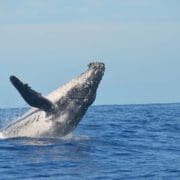Eco-Friendly Whale Watching: How to Choose a Responsible Tour Operator
Whale watching is a thrilling and educational experience, but it’s essential that it’s conducted with respect for the environment and the majestic creatures it aims to showcase. Eco-friendly whale watching ensures that the joy of observing whales doesn’t come at the expense of their well-being or the marine ecosystem. Australia Whale Experience stands out as a responsible tour operator, committed to sustainable practices.
Key Considerations for Eco-Friendly Whale Watching
- Respect for Wildlife: Look for operators that adhere to guidelines for approaching and observing whales, ensuring minimal disturbance.
- Environmental Stewardship: Consider the operator’s commitment to reducing pollution, conserving resources, and educating guests about marine conservation.
- Community Engagement: Responsible operators often work with local communities and contribute to conservation efforts.
Australia Whale Experience: A Commitment to Sustainability
Australia Whale Experience embodies the principles of eco-friendly whale watching through various practices:
- Adherence to Guidelines: They strictly follow the guidelines set by authorities, maintaining safe distances from the whales and limiting time spent with each sighting.
- Educational Focus: Guides provide insightful information about whale behaviour, conservation, and the marine ecosystem, fostering awareness and appreciation.
- Eco-Friendly Vessels: Their boats are designed to minimize pollution, with efficient engines and waste management systems.
- Support for Conservation: A portion of the proceeds from tours goes to support whale research and conservation initiatives.
Tips for Choosing a Responsible Tour Operator
- Research Credentials: Look for certifications or affiliations with reputable environmental organizations.
- Ask Questions: Don’t hesitate to ask about the operator’s sustainability practices and conservation efforts.
- Read Reviews: Look for feedback from previous guests about the operator’s commitment to eco-friendly practices.
- Consider the Whole Experience: Eco-friendly whale watching is not just about the whales; it’s about the entire marine environment. Look for operators that embrace a holistic approach to sustainability.
Whale watching is more than a tourist attraction; it’s a chance to connect with nature and learn about the incredible world beneath the waves. By choosing a responsible tour operator like Australia Whale Experience, you’re not only ensuring a memorable experience but also contributing to the well-being of the whales and the marine environment.
Eco-friendly whale watching is a choice that reflects a commitment to responsible tourism and a love for the natural world. It’s a choice that ensures that the thrill of seeing a whale breach or hearing its powerful song is a joy that future generations can also experience.
Book your eco-friendly whale watching tour with Australia Whale Experience today, and embark on a journey that celebrates the beauty of the ocean responsibly. It’s an adventure that satisfies the soul and the conscience, leaving you with memories that are both joyful and meaningful.








